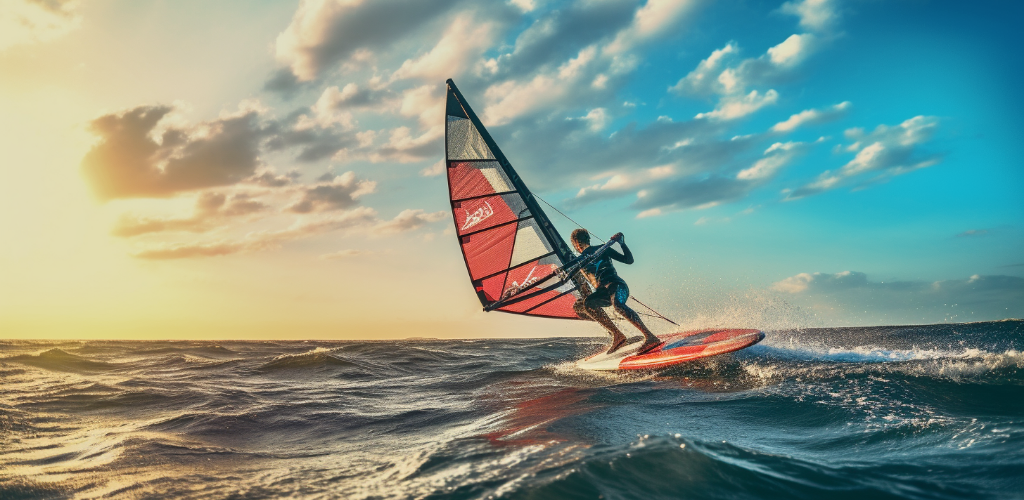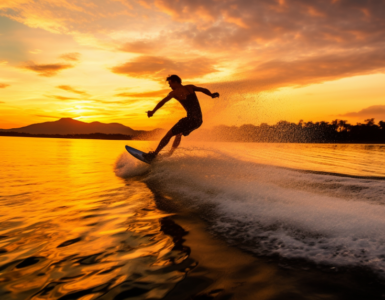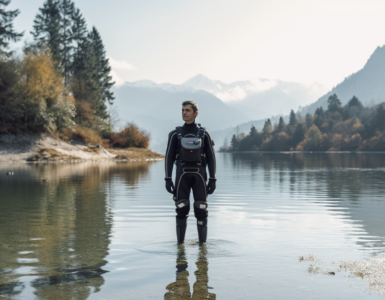Windsurfing, a dynamic and adrenaline-fueled water sport, has come a long way since its inception in the late 1960s. From humble beginnings to becoming an international sensation, the sport has evolved in tandem with advancements in equipment technology. At the heart of this evolution lies the windsurfing board.
Windsurfing is a unique blend of surfing and sailing, where riders harness the power of the wind to glide across the water’s surface. It’s a thrilling activity that can be done in various water bodies, from calm lakes to choppy sea waves. The allure of windsurfing lies not only in its exhilarating nature but also in the intricate dance between the rider, the board, and the elements.
Choosing the right board is crucial, as it can significantly influence your windsurfing experience. The board you select should align with your skill level and the conditions you plan to windsurf in. Sounds complicated? Don’t worry, we’ve got you covered with this comprehensive guide.
Understanding the Basics of a Windsurfing Board
Before we dive into the different types of windsurfing boards, let’s break down the fundamental parts of a board. The deck, the hull, the fin, and the footstraps – each of these components plays a vital role in how the board performs and maneuver.
The deck is the top surface of the board where the rider stands, and the hull is the board’s underside in contact with the water. The fin, protruding from the hull’s rear, helps in steering and stability. Lastly, the footstraps are where a rider places their feet to secure themselves to the board while performing maneuvers. Understanding these basics will help you appreciate the nuances of different board types.
The Role of Personal Skills and Environment in Choosing a Windsurfing Board
When it comes to selecting a windsurfing board, one size definitely does not fit all. Your skill level and the conditions you plan to windsurf in are crucial factors to consider.
Are you a beginner just starting to learn the ropes? An intermediate rider looking to improve your skills? Or an advanced windsurfer seeking high-performance boards for speed and agility? Each skill level has boards designed to cater to specific needs.
Moreover, the conditions of the water and the wind also play a critical role. Windsurfing in flat water, waves, or under different wind conditions can dramatically alter the performance of the board. Hence, it’s crucial to match the board type with the environment you’ll be windsurfing in.
Beginner Windsurfing Boards
Are you just starting your windsurfing journey? If so, you’ll need a board that’s forgiving, easy to balance on, and designed to help you master the basics. Beginner windsurfing boards are typically larger and more stable than their advanced counterparts. This stability isn’t a design flaw—it’s a feature! It helps beginners get a feel for the water and wind without being overly concerned about maintaining balance. With these boards, you can focus on learning the ropes and developing your skills in a fun, stress-free manner. Isn’t that what learning a new sport should be about?
Recommended Beginner Boards
Choosing the right board as a beginner can be a bit overwhelming, given the vast number of options available on the market. But don’t worry! We’ve got you covered. Here’s a list of beginner boards that are highly recommended for their quality, stability, and overall performance:
- Fanatic Viper: A versatile board that’s perfect for learners. Its large, stable design makes it easy to balance on, while its durable construction ensures it can withstand the inevitable bumps and scrapes that come with learning.
- JP Australia Funster: This board is known for its excellent stability and ease of use, making it an ideal choice for beginners
- Starboard Start: As the name suggests, this board is designed for starters. It’s wide and stable, providing a great platform for learning the basics of windsurfing.
Intermediate Windsurfing Boards
Now, what if you’ve mastered the basics and are ready to take your windsurfing to the next level? That’s where intermediate boards come into play. These boards are smaller and offer more maneuverability than beginner boards. They’re designed to help you improve your skills and start experimenting with more advanced techniques. Imagine the thrill of being able to control your board more precisely, catch larger waves, and maybe even try out some tricks! Sounds exciting, doesn’t it?
Recommended Intermediate Boards
Ready to level up? Here are some intermediate boards that come highly recommended:
- RRD Firemove: Known for its combination of stability and maneuverability, the Firemove is a popular choice among intermediate windsurfers.
- Tabou Rocket Wide: This board is designed for speed and control. It’s perfect for intermediates looking to push their limits and explore new aspects of the sport.
- Starboard CarveIQ: This board is versatile and fun. It’s designed for windsurfers who want to improve their carving and maneuvering skills.
Advanced Windsurfing Boards
So, you’ve mastered the windsurfing basics and can handle intermediate boards with ease? It’s time to take a look at the advanced windsurfing boards. These boards are the epitome of speed and agility on the water. They’re not for the faint of heart, but for those who crave high performance and the thrill of pushing their limits.
Advanced boards are typically shorter than beginner and intermediate boards. They have less volume, making them more responsive and quicker to plane. The reduced size and advanced design features allow for swift direction changes and the ability to surf bigger waves. Are you up for the challenge?
Recommended Advanced Boards
- Bic Techno Wind Foil: A versatile, high-performance board with integrated foil mount. Ideal for both foiling and traditional windsurfing.
- Starboard iSonic Speed Slalom: This board offers blistering speed and is designed for experienced windsurfers seeking to participate in races.
- JP Australia Super Sport: It is known for its speed, control, and acceleration. This board is perfect for those who want to push their limits.
Freestyle, Wave, and Slalom Boards
Did you know there are also specialized boards designed for specific types of windsurfing? That’s right! There’s more to windsurfing than meets the eye. Let’s take a look at freestyle, wave, and slalom boards.
Freestyle boards are designed for tricks and maneuvers, with a flat rocker line and a compact shape for quick spins. Wave boards, on the other hand, are built for surfing and jumping in wave conditions. They have a high rocker line and are usually shorter for maximum maneuverability on waves. Lastly, slalom boards are built for speed and racing. They are longer and have a flat rocker line to achieve maximum speed.
Each of these boards is designed with a specific purpose in mind, and they truly shine in their intended conditions. So, which one catches your eye?
| Board Type | Designed For | Key Features |
|---|---|---|
| Freestyle Boards | Tricks and Maneuvers | Flat Rocker Line, Compact Shape |
| Wave Boards | Surfing and Jumping in Waves | High Rocker Line, Short Length |
| Slalom Boards | Speed and Racing | Flat Rocker Line, Longer Length |
Key Factors to Consider When Choosing a Windsurfing Board
So, you’re all set to get your own windsurfing board? Great! But before you do, there are some key factors you should consider to ensure you get the right board for your needs. These include your weight, board volume, board width, and weather conditions.
Your weight is a significant factor because it determines the size of the board you’ll need. A larger person will need a larger board than a lighter person.
The board volume, which refers to the board’s buoyancy, also plays a vital role. As a rule of thumb, beginners should go for boards with higher volumes for better stability. As you advance, you can opt for boards with lesser volume for more agility and speed.
The board width is another crucial factor to consider. A wider board offers more stability and is excellent for beginners. Narrower boards, on the other hand, are more challenging to balance but offer better speed and performance.
Finally, weather conditions, particularly wind conditions, can greatly affect your choice of board. Stronger winds call for smaller boards, while lighter winds require larger boards.
Maintaining and Caring for Your Windsurfing Board
Once you’ve chosen the perfect board, it’s essential to keep it in top condition. After all, a well-maintained board not only performs better but also lasts longer. So how do you take care of your windsurfing board?
Firstly, always clean your board after every use. Rinse it with fresh water to remove any salt, sand, or other debris. This not only keeps your board looking good but also prevents potential damage.
Secondly, make sure to store your board properly. Keep it in a cool, dry place away from direct sunlight. Also, avoid storing it under heavy items to prevent dents or cracks.
Lastly, regularly inspect your board for any signs of wear and tear. If you spot any damage, get it repaired immediately to prevent further deterioration.
Wrapping Up
In conclusion, choosing the right windsurfing board can make a significant difference in your windsurfing experience. It’s not just about picking the most expensive or the most popular board. It’s about finding the one that suits your skill level, your body weight, and the conditions where you’ll be windsurfing.
Remember, each board type has its own unique features and advantages. So take your time, do your research, and if possible, try out different boards before making your final decision. It’s worth the effort!
- Consider your weight, board volume, and board width when choosing a board.
- Keep in mind the weather conditions where you’ll be windsurfing.
- Maintain your board by cleaning it after use and storing it properly.
- Regularly inspect your board for any signs of damage.
- Take your time to research and try out different boards before making a decision.




